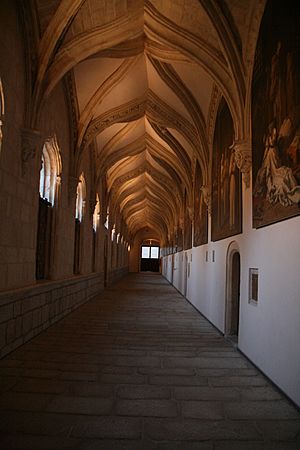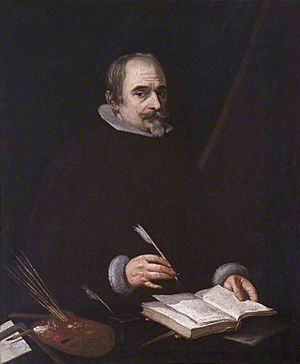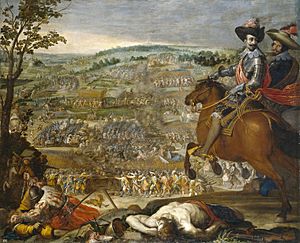Vincenzo Carducci facts for kids
Vincenzio Carduccio (also known as Vicente Carducho in Spanish) was an Italian painter. He was born in 1576 or 1578 and lived until 1638. Vicente spent his entire career working in Spain.
Early Life and Training
Vicente Carducho was born in Florence, Italy. He learned how to paint from his older brother, Bartolomeo Carducho. When Vicente was a boy, he followed his brother to Madrid, Spain.
Working for the Kings
Vicente helped his brother paint for Philip II of Spain at the Escorial. He also painted some artworks in Valladolid.
In 1606, Vicente returned to Madrid to work for Philip III of Spain. He helped decorate the Palacio del Pardo, a royal palace that had just been rebuilt. When his brother passed away, Vicente took over his painting projects. He painted a series of artworks about the hero Achilles for the palace.
After this, he worked for four years at the Monastery of El Paular. He painted 54 large pictures for the monastery's main cloister. These paintings showed important historical figures. Twenty-seven of them told the story of Saint Bruno, and the other twenty-seven showed martyrs (people who died for their beliefs).


Vicente continued to work for the next king, Philip IV of Spain. Many of his best paintings were made for the king. Today, you can see many of them in the Prado Museum in Madrid. His art can also be found in cities like Toledo and Segovia in Spain.
Teacher and Writer
For many years, Carducho was a respected art teacher in Madrid. Some of his famous students included Juan Rizi, Pedro de Obregón, Vela, and Francisco Collantes. These students became important Spanish painters in the 1600s.
In 1633, Carducho wrote a book called De las Excelencias de la Pintura. It is also known as Diálogos de la pintura, su defensa, origen, essencia, definición, modos, y diferencias. This book was written as a conversation between a master painter and a student.
In his book, Carducho wrote about how important it was for painters to be respectful and thoughtful, especially when painting religious figures. He believed that artists should pray before painting holy subjects. He wrote that a painter should never start painting without first thinking and improving their soul. He mentioned a holy painter, Brother Juan Fesulano, who always prayed before painting and even cried when painting Christ on the Cross.
Carducho also shared his opinions on other artists. He did not like the very realistic style of some painters, like Velázquez. He was especially critical of Caravaggio and his followers. Carducho felt that Caravaggio's new style was very popular but might lead other painters away from the true rules of art. He wondered how Caravaggio could paint so well without much preparation or traditional training. Carducho believed that Caravaggio's style, while amazing, might cause problems for painting in the long run.
Legacy
Vicente Carducho passed away in Madrid.
The largest collection of his artworks is kept at the Prado Museum. The Real Academia de Bellas Artes de San Fernando also has two of his paintings. These were originally made for the Basilica de San Francisco el Grande in Madrid.
See also
 In Spanish: Vicente Carducho para niños
In Spanish: Vicente Carducho para niños



